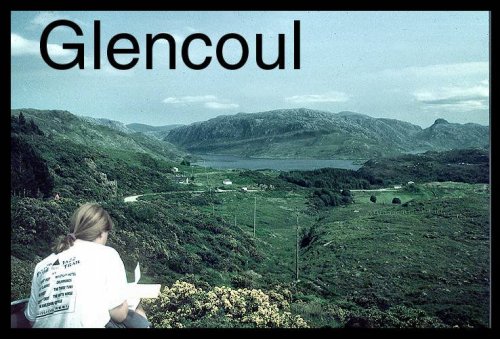Link to map, cross-section and photographs - Satellite image of the Glencoul area
GLENCOUL (NC236304 - NC295288)
Loch Glencoul is a spectacular glacier-carved fjord with steep valley sides that leads into the remote country east of the Ben More Assynt range. The dramatic scenery also provides one of the most important sections exposed through the Moine Thrust Belt. The view provided by the slopes of Beinn Aird da Loch, on the northern side of Loch Glencoul, has inspired generations of geologists since Callaway (1883) first recognised its significance. Lewisian gneisses have been emplaced upon a thin tract of imbricated An t-Sron Formation resting on intact Cambrian quartzites that in turn lie unconformably upon Lewisian of the foreland. The tectonic contact was termed the Glencoul Thrust (Peach et al., 1907). The displaced Lewisian in its hanging-wall has its own cover of Cambrian quartzites that are overlain by Moine metasediments. Again Callaway (1883) interpreted these relationships in terms of tectonic contacts; this is the Moine Thrust. Its dramatic exposure on the Stack of Glencoul includes several hundred metres of mylonites derived both from the Moine and the underlying Cambrian quartzites. The foreland part of the Glencoul site has additional structural significance in that the famous 'double unconformity' between Lewisian, Torridonian and Cambrian units is exposed.
The Glencoul area provides unrivalled opportunities for understanding the large-scale structure of thrust belts, particularly the incorporation of slices of crystalline basement. Lewisian of the Glencoul Thrust Sheet has experienced between 25km and 33km of displacement but with virtually no internal strain. The thrust surface and underlying imbricates are well-exposed around the head of Loch Glencoul.
The Moine Thrust at the Stack of Glencoul is a ductile shear zone that is marked by mylonites. Cambrian quartzites which dominate the lower part of the shear zone show spectacular deformed Skolithos which record combinations WNW-directed overshear and layer-parallel extension. These quartzites have been important for qualitative and quantitative studies of mylonite formation through crystallographic analysis. The upper parts of the Moine Thrust Belt here contains imbricate thrusts and recumbent folds together with ductile extensional structures and normal faults. WNW-directed overshear appears to be the consistent kinematic condition for all these structures, whether compressional or extensional. These relationships, formed during the emplacement of the Moine Thrust Sheet, may be explained by gravitational spreading or by cyclic localisation of shear displacements. Thus the area is important for understanding the early history of the Moine Thrust Belt and for the development of dynamic models of thrust tectonics.
Link to map, cross-section and photographs - Satellite image of the Glencoul area
